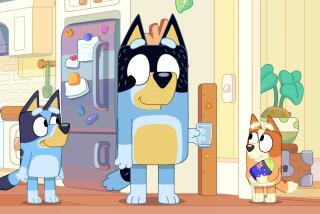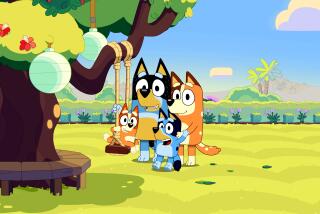School for Thought
- Share via
Nickelodeon, the kids’ cable network, has cannily won young viewers’ hearts over the years with its humorously anarchic “you can’t do that on television” attitude, buckets of green slime and offbeat cartoons. It does, however, have a kinder, gentler side.
You won’t find slime or attitude on Nick Jr., the 9 a.m. to 2 p.m. programming bloc for preschoolers. Gentle shows such as “Gullah, Gullah Island” and “Allegra’s Window” match PBS competitors with their meticulous attention to principles of child development. Now, the special appeal of relative newcomer “Blue’s Clues,” a weekday “game show” that premiered in the fall of 1996, has become Nick Jr.’s star attraction, consistently ranking No. 1 in commercial TV offerings for ages 2 to 5. (PBS’ “Barney” and “Arthur” still dominate overall among those young viewers, however.)
Set in a computer-generated, charming world of animated, 3-D cut-out art, “Blue’s Clues” is also a star player in terms of innovative visual design, viewer interaction and educational precepts. A “think-along” show, it encourages viewers to learn and use problem-solving skills, ostensibly helping human host Steven Burns figure out the name of a nursery rhyme, an activity or object, guided by a sweet cartoon puppy named Blue and her blue pawprints.
“The idea is not to tell kids what to think, but to encourage them to think for themselves,” said executive producer Todd Kessler, who created the show with designer Traci Paige Johnson and head writer Angela C. Santomero.
“Our mission statement is to challenge, empower and build the self-esteem of preschoolers, while making them laugh,” Kessler said. “Building self-esteem is linked to thinking skills and independent thinking.”
The distinctive, deceptively simple look of the show--colorful, organic and textured--is Paige Johnson’s creation. “It’s very graphic and simple, like a children’s picture book. I’m not a traditional animator,” she said. “I’m more of a folk artist.”
Using such materials as pipe cleaners, paper and clay, desktop computers and common software, Johnson’s anthropomorphic designs--from talking salt and pepper shakers, clocks and desks, to the storybooks that viewers and host become a part of while clue-searching--are computerized, retaining their three-dimensionality and homemade, folk-crafty look.
“It was Tracy’s idea to bring real objects into the computer, real textures, real items, real props,” said Kessler, “and that gave it a noncomputerized look. We worked with the animation to make it more organic and give weight to it, rather than have it be that floaty computer animation.”
“I’m excited about exposing kids to something visually different,” Paige Johnson said.
As the show’s host, Burns represents the only live action in an otherwise animated environment, except for a regular segment showing video “letters” from real kids engaged in play and everyday activities.
“I’m the only actor I know who works this extensively with blue screen, without other actors or objects. It looks like I’m at the bottom of a swimming pool, talking to individual microns of air,” he said with a laugh.
Budgetary constraints were a factor in ruling out extensive live action, Kessler said, but he felt a real person in the show was essential to connect with viewers. Professional actor and voice-over artist Burns, 24, turned out to be an inspired choice: He shares “Mister Rogers’ Neighborhood” icon Fred Rogers’ gift for seeming to speak directly and sincerely to his viewers.
“We were talking to a child development professor at Howard University,” said Brown Johnson, senior vice president of Nick Jr. (but no relation to Paige Johnson), “and she said if her students didn’t get down on their knees to talk to kids, she didn’t want them to be her students. We took that to heart. We feel that all Nick Jr. shows need to get down on their knees to talk to kids, to engage them and make them feel important. That’s what Steve does.”
“Blue’s’ ” most fundamental strengths are its clarity of expression, its calm, unhurried pace--the creators all cite Fred Rogers as an inspiration--and its scheduling. The same episode airs each day throughout a given week.
“From a child-development point of view,” said Santomero, “repetition is the key to learning. For a child to be able to master a set of skills, they need to look at something over and over again, have the same story read to them, or play the same game, or see the same home video, because they’re trying to master it. They love it when they can sing the words, or know what the answer is and why that’s the answer.
“It was a huge thing for Nickelodeon to agree to,” she added.
“Absolutely,” confirmed Brown Johnson. When the show debuted, “we were all ready with operators primed to talk to parents who called to complain” about the repetition. Not many did.
“Once we explained why, they were like, ‘Oh, yeah, I get that.’ It was much more of an issue internally than externally. Now, parents write to us and tell us how proud their kids are of themselves by Wednesday, when they can play most of the games.”
“Once we started the repeat strategy,” Kessler said, “we realized we could make the shows more challenging, so that by day five there’s still stuff to work on and figure out.”
“Blue’s Clues” airs weekdays at 9:30 a.m. and 12:30 p.m., and weekends at 6:30 a.m. on Nickelodeon.
More to Read
The complete guide to home viewing
Get Screen Gab for everything about the TV shows and streaming movies everyone’s talking about.
You may occasionally receive promotional content from the Los Angeles Times.






